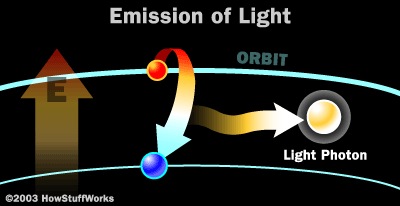
A laser is a device that controls the way that energized atoms release photons. "Laser" is an acronym for light amplification by stimulated emission of radiation , which describes very succinctly how a laser works.
In a laser, the lasing medium is “pumped” to get the atoms into an excited state. Typically, very intense flashes of light or electrical discharges pump the lasing medium and create a large collection of excited-state atoms (atoms with higher-energy electrons).
The key here is critical mass.
It is necessary to have a large collection of atoms in the excited state for the laser to work efficiently. In general, the atoms are excited to a level that is two or three levels above the ground state. This increases the degree of population inversion. The population inversion is the number of atoms in the excited state versus the number in ground state.
Electrons in excited levels have more energy than electrons in the ground state. As these fall down in energy levels photons are emitted. Now, if your have the "right" kind of atom, then you can get photon emission, via level transitions, that all have very similar wavelengths.
Consider this case. If you pump the electron up to the largest excited state (Energy = 50.35) then as it falls down to the successive state each photon which is emitted is approximately at the same wavelength. In this case we would get a quasi green laser.

Laser light is very different from normal light. Laser light has the following properties:
To make these three properties occur takes something called stimulated emission. This does not occur in your ordinary flashlight -- in a flashlight, all of the atoms release their photons randomly. In stimulated emission, photon emission is organized
The photon that any atom releases has a certain wavelength that is dependent on the energy difference between the excited state and the ground state. If this photon (possessing a certain energy and phase) should encounter another atom that has an electron in the same excited state, stimulated emission can occur. The first photon can stimulate or induce atomic emission such that the subsequent emitted photon (from the second atom) vibrates with the same frequency and direction as the incoming photon.
Hence, a long signal chain of atoms with this property will end up emitting a train of photons all in the same direction with all exactly the same or nearly the same wavelength.
The other key to a laser is a pair of mirrors, one at each end of the lasing medium. Photons, with a very specific wavelength and phase, reflect off the mirrors to travel back and forth through the lasing medium. The mirror at one end of the laser is "half-silvered," meaning it reflects some light and lets some light through. The light that makes it through is the laser light.
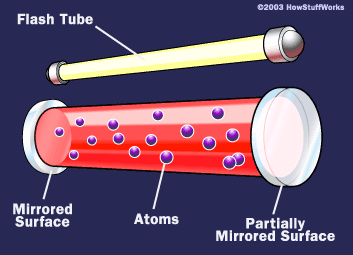
In the process, they stimulate other electrons to make the downward energy jump and can cause the emission of more photons of the same wavelength and phase.
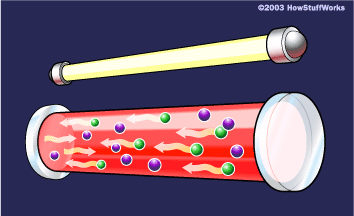
A cascade effect occurs, and soon we have propagated many, many photons of the same wavelength and phase
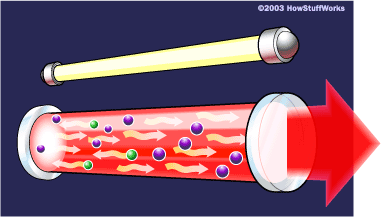
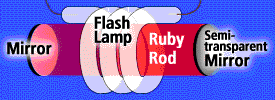
In the non-lasing state the "cavity" (this is the area between the mirrors where the atoms are located) does nothing. When the flash tube fires, it injects photons (light energy) into the cavity which causes the initial excitation of the atoms.
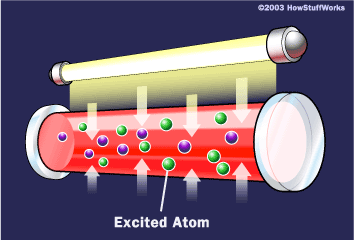
Some of those initially excited atoms emit photons which then stimulate the emission of other atoms as previously described.
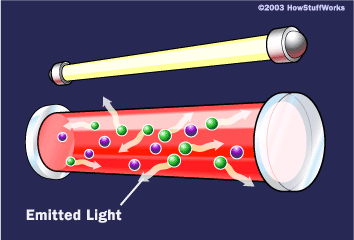
The Three Level laser
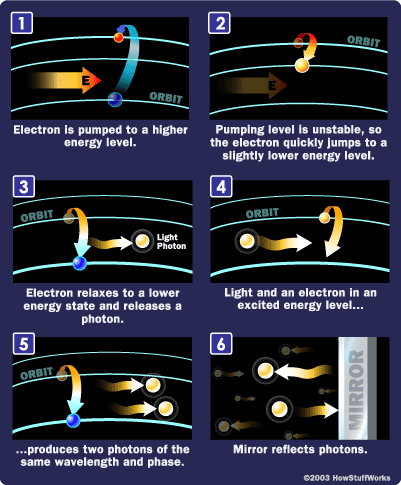
Different Types of Lasers:
The laser medium can be a solid, gas, liquid or semiconductor. Lasers are commonly designated by the type of lasing material employed:
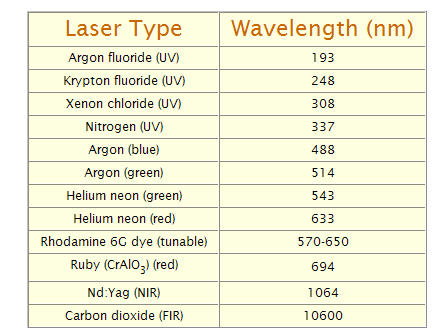
Now that we have developed the laser, how can we use it to transmit lots of information?
Clearly, a monochromatic laser can not transmit much information, just power at one wavelength.
They key breakthrough here was the development of wavelength-division multiplexing (WDM), the transmission of data over multiple wavelengths.
Each wavelength adds a transmission lane to the information superhighway; the more lanes there are, the more traffic -- voice, data, video -- can be carried on a single fiber  note we will discuss optical fibers next tuesday
note we will discuss optical fibers next tuesday
Two approaches:
This works by taking advantage of the fact that different wavelengths in a light pulse travel through optical fiber at different speeds -- red light propagates faster than blue. Each wavelength arrives at the end of a fiber at a slightly different time so that the data can then be encoded sequentially onto the WDM channels using a single data modulator.
The key here is that travel times are on the order of a few nanoseconds for each wavelength so you need a modulation source which can do ultrafast switching and that's this is characteristic of a femtosecond laser.
These WDM systems are capable of transmission rates of 100 million bits per second through optical fibers and clearly this will be the technology of our new bandwidth. Currently this is still very much in the R&D phase.
At the moment, WDM which has now become D (dense) WDM can encode hundreds of channels of different wavelength on a single optical fiber.